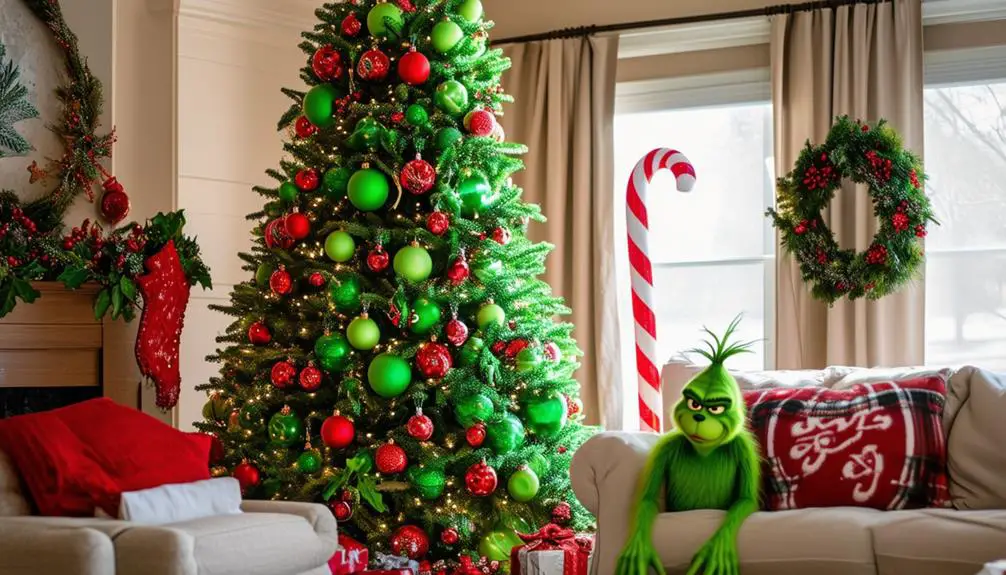As you start planning your succulent garden, you'll quickly realize the possibilities are endless. You can opt for a modern, sleek design or a whimsical, rustic setup – the choice is yours. You might consider geometric planters, vertical wall gardens, or hanging baskets to add some visual flair. But that's just the beginning. You can also create a themed garden, like a coastal or desert-inspired landscape, or experiment with mini gardens and colorful arrangements. The question is, where will your creativity take you?
Modern Succulent Container Gardens
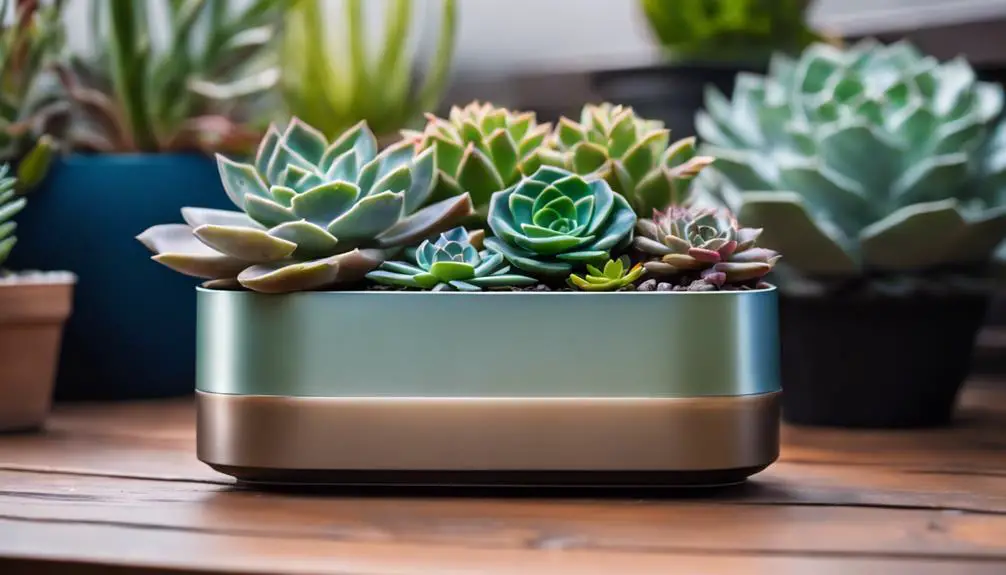
Create a sleek, modern look by choosing containers with clean lines, minimal ornamentation, and a focus on geometric shapes to showcase your succulents.
This Urban Chic aesthetic is perfect for contemporary spaces, and Contemporary Vases made from materials like glass, ceramic, or concrete are ideal for achieving this look.
You'll want to select containers that complement the structural beauty of your succulents, rather than distracting from them. Consider cylindrical or rectangular shapes, which will provide a clean backdrop for your plants.
When selecting a vase, think about the scale and proportion of the container to the succulents. You want the arrangement to feel balanced and harmonious.
Don't be afraid to experiment with different textures, colors, and materials to add visual interest.
For a bold statement, group multiple containers together to create a striking succulent installation.
Whimsical Fairy Garden Designs

You can transport yourself to a miniature world of wonder by designing a whimsical fairy garden, where succulents take center stage amidst a backdrop of tiny furniture, moss, and pebbles.
To create this enchanting scene, start by selecting a shallow container or a designated area in your garden. Choose a variety of succulents with unique shapes and textures, such as echeveria, crassula, or sedum, to create a visually appealing arrangement.
Add miniature furniture, like tiny benches or tables, to create a sense of scale. Incorporate moss and pebbles to create a natural, whimsical atmosphere.
To add an extra touch of magic, incorporate fairy figurines and miniature bridges to create a sense of narrative. You can place fairy figurines amidst the succulents, as if they're tending to the plants.
Miniature bridges can connect different areas of the garden, creating a sense of adventure and exploration. By combining these elements, you'll create a whimsical fairy garden that's sure to delight and inspire.
With a little creativity, you can transport yourself to a world of wonder and magic, right in your own backyard.
Succulent Vertical Wall Planters
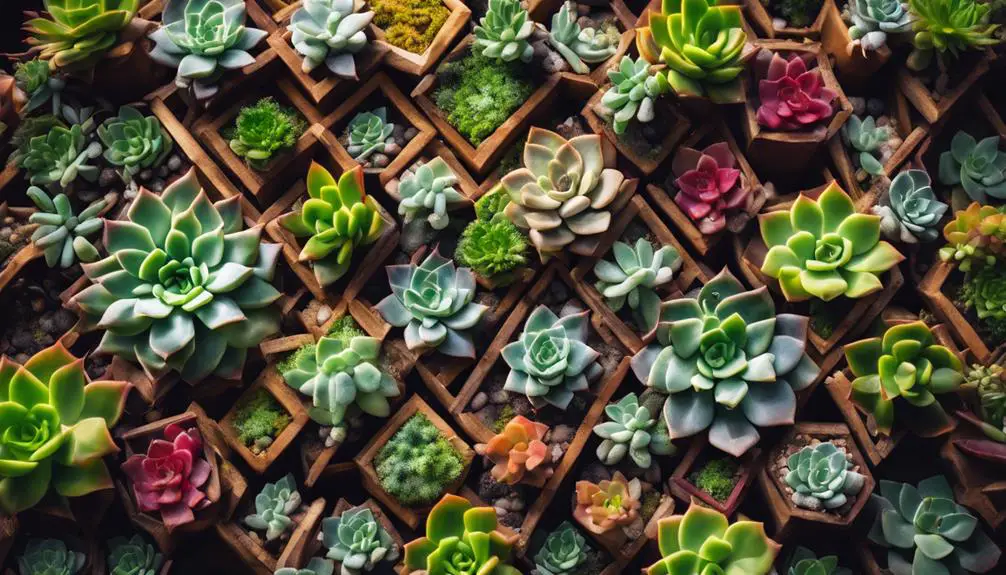
Now that you've decided to create a succulent vertical wall planter, you'll need to choose a design that suits your space and style.
You'll select a wall planter that complements your home's exterior or interior, considering factors like material, size, and drainage.
Next, you'll arrange your succulents in a visually appealing way, taking into account their textures, colors, and growth patterns.
Wall Planter Designs
Incorporating succulent vertical wall planters into your garden design allows for a visually striking and space-saving way to showcase your favorite species. You can create a stunning wall art piece that doubles as a living display of succulents.
These planters are perfect space savers for small gardens or balconies, as they utilize vertical space without taking up valuable floor area.
When designing your wall planter, consider the type of succulents you'll be using. Some species, like aloe and echeveria, have a more compact growth habit, making them ideal for smaller planters. Others, like sedum and crassula, can trail down, creating a beautiful cascading effect.
You can also mix and match different species to create a unique and visually appealing display.
Choose a planter that complements your garden's aesthetic, whether it's modern, rustic, or minimalist.
You can opt for a sleek, rectangular planter or a more rustic, wooden one. Whatever design you choose, your succulent vertical wall planter is sure to be a conversation starter and a beautiful addition to your outdoor space.
Succulent Arrangement Tips
When selecting succulents for your vertical wall planter, balance is key, so choose a mix of plants with varying textures, colors, and growth habits to create a visually appealing arrangement.
This succulent selection will guarantee your wall planter looks dynamic and mesmerizing.
For a cohesive look, consider an arrangement style that groups plants with similar growth habits together.
You can also create a focal point by placing a statement succulent, like an aloe or echeveria, in the center of the planter.
Experiment with different arrangement styles, such as a symmetrical or asymmetrical design, to add visual interest.
Don't be afraid to mix and match different succulent species to create a unique look.
Consider the lighting conditions and maintenance requirements of each succulent when selecting and arranging your plants.
By doing so, you'll create a thriving and beautiful succulent arrangement that will enhance your outdoor or indoor space.
With a little creativity and experimentation, your vertical wall planter will become a stunning showpiece that showcases your innovative succulent arrangement skills.
Rustic Wooden Planter Boxes

You can create a charming succulent display by using rustic wooden planter boxes, which add a natural, earthy touch to your garden or indoor space.
To achieve this, consider using reclaimed wood, which brings a sense of history and character to your planters. Look for wood with a weathered, distressed finish to add texture and visual interest. You can also experiment with different wood tones and stains to create a unique, one-of-a-kind look.
When choosing a rustic wooden planter box, consider the size and shape that will best showcase your succulents.
Rectangular or square planters work well for creating a modern, geometric arrangement, while circular planters add a softer, more organic feel.
Make sure the planter has drainage holes to prevent waterlogged soil, and consider adding a trellis or other support for taller succulents.
With a little creativity, you can create a stunning rustic wooden planter box that highlights the beauty of your succulents and adds a touch of rustic charm to your space.
Mini Succulent Terrariums
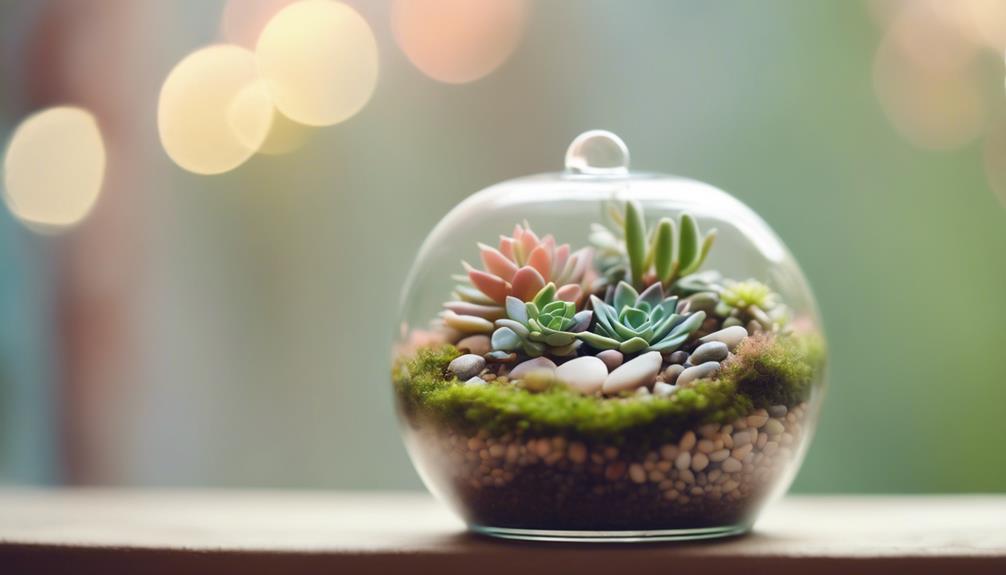
Mini succulent terrariums offer a compact, low-maintenance way to showcase your favorite succulent species, allowing you to create a visually striking arrangement in a small, self-sustaining environment.
You can easily customize your terrarium by selecting a variety of succulent species, each with its unique texture, shape, and color.
To add visual interest, incorporate tiny decorations such as small rocks, seashells, or miniature figurines that complement your succulents.
When assembling your terrarium, start by adding a layer of small rocks or pebbles at the bottom for drainage.
Next, add a layer of activated charcoal to prevent mold growth, followed by a layer of potting soil.
Plant your succulents, leaving enough space for growth and air circulation.
Add decorative elements, such as moss or small branches, to create beautiful layers.
Finally, top with a layer of small rocks or pebbles to complete the look.
With minimal care, your mini succulent terrarium will thrive, providing a stunning display of natural beauty in a small, enclosed space.
Colorful Succulent Arrangements

When creating colorful succulent arrangements, you'll want to ponder vibrant color combinations that pop against each other.
Think bold blues paired with bright yellows, or soft pinks paired with deep purples.
Vibrant Color Combinations
Vibrant color combinations can elevate your succulent garden's visual appeal by pairing bold, bright hues with softer, pastel shades to create striking contrasts.
By doing so, you'll add depth and visual interest to your arrangement. To achieve this, start by selecting a bold, focal-point succulent with bright colors like red, orange, or yellow.
Then, surround it with succulents featuring pastel hues like pale pink, baby blue, or mint green. This contrast will draw the eye and create a visually appealing display.
When choosing bold contrasts, consider the natural colors of the succulents.
For example, pair a bright red aloe with softer, blue-green echeveria. You can also experiment with different shades of the same color, like pairing a deep blue succulent with a lighter, sky blue one.
Geometric Pattern Designs
By incorporating geometric patterns into your succulent arrangements, you can create visually striking designs that add an extra layer of sophistication to your garden.
One popular approach is to use triangle patterns to create a sense of movement and energy. You can arrange succulents in triangular formations, alternating between large and small plants to create visual interest.
Another technique is to create a mosaic art piece using small succulents of different colors and textures. By arranging these tiny plants in a precise pattern, you can create a stunning work of art that adds a touch of modernity to your garden.
To take your geometric pattern designs to the next level, experiment with different shapes and colors.
Consider using a combination of circular and angular shapes to create a visually appealing contrast. You can also incorporate other decorative elements, such as rocks or pebbles, to add texture and depth to your design.
Succulent Hanging Baskets Ideas
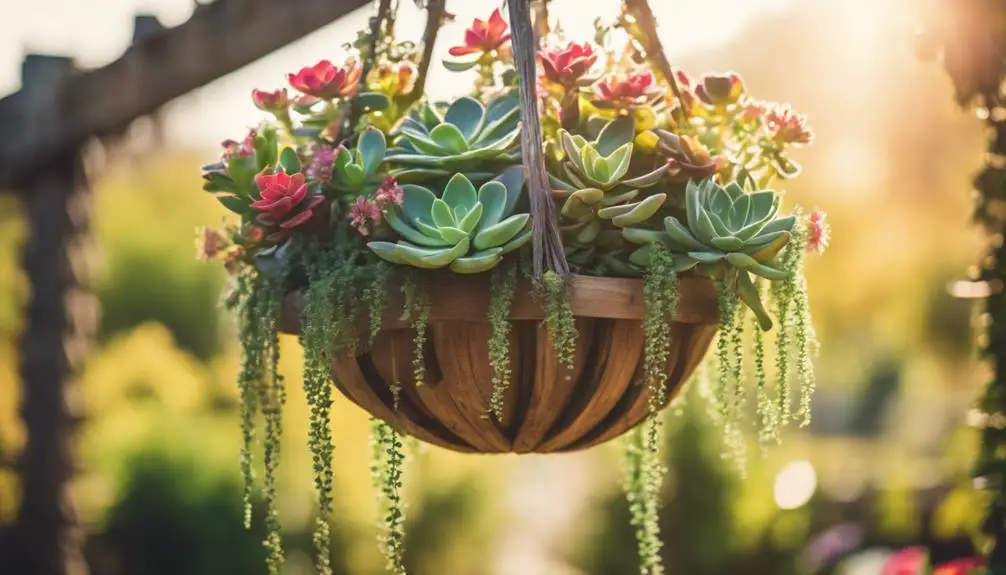
You can create a stunning display of succulents with hanging baskets, which allow for maximum visibility and versatility in terms of placement.
By using hanging baskets, you can add a unique dimension to your succulent garden, creating a striking visual effect.
One idea is to create succulent cascades, where the plants flow downwards, creating a beautiful, lush display. To achieve this, choose a basket with good drainage and a sturdy chain or rope.
Select succulents with trailing stems, such as sedum or burro's tail, and plant them in a way that allows them to spill over the edges of the basket.
Another approach is to use basket draping, where you place the succulents around the basket, creating a beautiful, textured display.
This method works well with succulents like echeveria or crassula, which have a more compact growth habit.
When choosing your succulents, consider the amount of light and temperature your hanging basket will receive, and select plants that are suitable for those conditions.
With a little creativity, you can create a stunning succulent hanging basket that adds a touch of elegance to your garden or indoor space.
Desert Inspired Landscape Designs

As you design your desert-inspired landscape, you'll want to create a visually striking contrast between soft, blooming succulents and rugged, rocky terrain elements.
You can achieve this by incorporating design features that mimic the natural beauty of the desert, such as sprawling cacti and carefully placed boulders.
Desert Blooming Oasis Creation
To create a desert blooming oasis, incorporate drought-tolerant plants, such as cacti and succulents, into your landscape design to mimic the natural beauty of arid regions.
You'll be amazed at how these resilient plants thrive in harsh conditions, providing a stunning display of vibrant desert flowers. Consider adding a variety of succulents with unique shapes, sizes, and colors to create visual interest.
When selecting plants, choose species that bloom at different times to guarantee year-round color.
For example, aloe vera blooms in winter, while echeveria produces vibrant flowers in spring. Incorporate these plants into your oasis design, along with decorative elements like natural stone, gravel, or sand to create a desert-inspired aesthetic.
Add some oasis decor, such as a statement piece of outdoor art or a unique water feature, to create a sense of tranquility.
Rocky Terrain Design Elements
Incorporating rocky terrain design elements into your desert-inspired landscape design can add depth and visual interest, particularly when paired with the drought-tolerant plants and decorative features discussed earlier.
You can achieve this by incorporating rocky accents, such as large boulders or smaller rocks, strategically throughout your garden. These natural elements won't only add texture but also create a sense of ruggedness, reminiscent of the desert landscape.
To further enhance the rocky terrain design, consider incorporating varying terrain textures.
For example, you can create a mix of smooth, flat areas and rough, rocky surfaces. This contrast will add visual interest and create a sense of dynamic movement.
Additionally, you can use rocks of different sizes, colors, and shapes to create a visually appealing pattern.
Succulent Tabletop Gardens
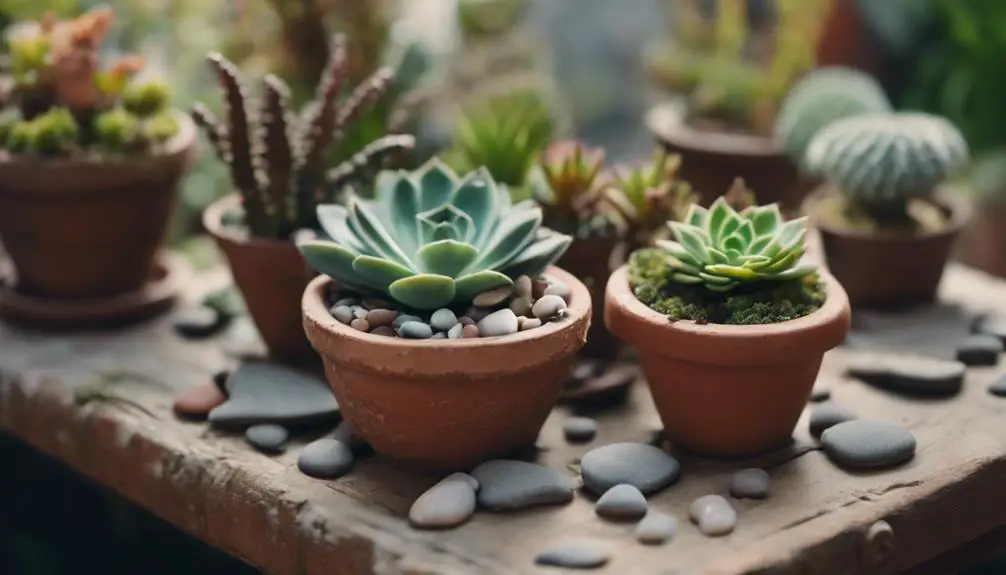
You can create a stunning succulent tabletop garden by selecting a shallow container with good drainage and a well-draining potting mix specifically designed for cacti and succulents. This will guarantee that your plants thrive and don't suffer from waterlogged soil.
When choosing your succulents, consider a mix of textures, colors, and sizes to add visual interest to your tabletop theme.
For a modern succulent decor, opt for sleek, minimalist containers in neutral tones like white, gray, or black. You can also add decorative rocks, pebbles, or marbles to create a visually appealing contrast.
If you prefer a more rustic look, consider a wooden or terracotta planter and add some moss or small pebbles around the base of the plants.
To add an extra layer of interest to your tabletop theme, incorporate decorative elements like seashells, small figurines, or other ornaments that complement your chosen style.
Geometric Succulent Planters
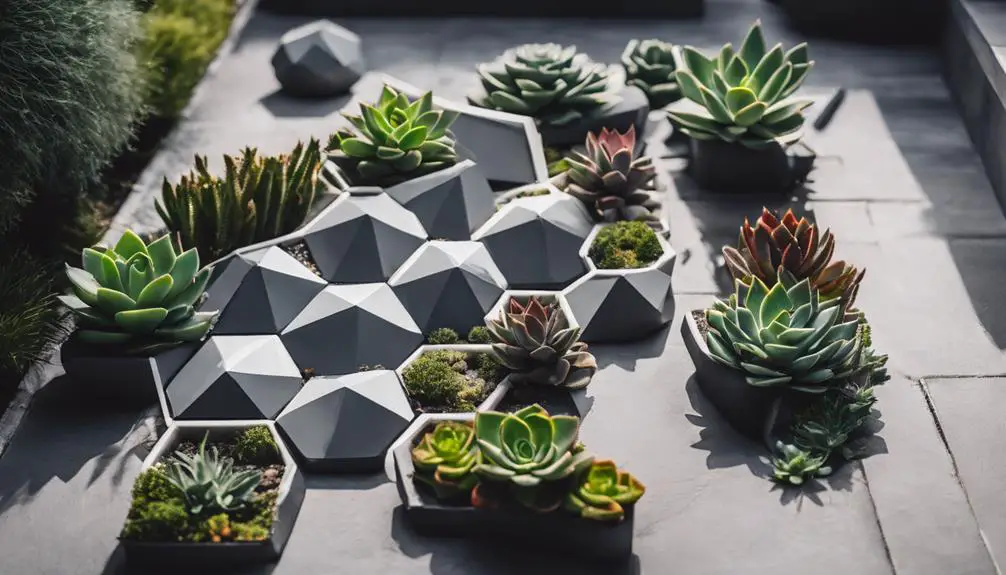
Geometric planters, with their clean lines and modern silhouette, provide a striking backdrop for showcasing succulents, allowing their unique shapes and textures to take center stage.
You can create a visually stunning succulent arrangement by combining different planter patterns, such as chevrons, hexagons, or triangles, to add depth and visual interest.
When selecting a geometric planter, consider the scale and shape of your succulents to guarantee a harmonious composition. For example, tall, slender succulents pair well with vertical planters, while round, plump succulents look great in spherical planters.
To elevate your succulent art, experiment with different materials, such as concrete, ceramic, or metal, to add texture and contrast to your arrangement.
You can also incorporate other design elements, like moss, pebbles, or small decorative rocks, to create a unique and engrossing succulent display.
By combining geometric planters with thoughtful succulent selection and arrangement, you'll create a show-stopping piece of succulent art that's sure to impress.
Coastal Succulent Garden Ideas
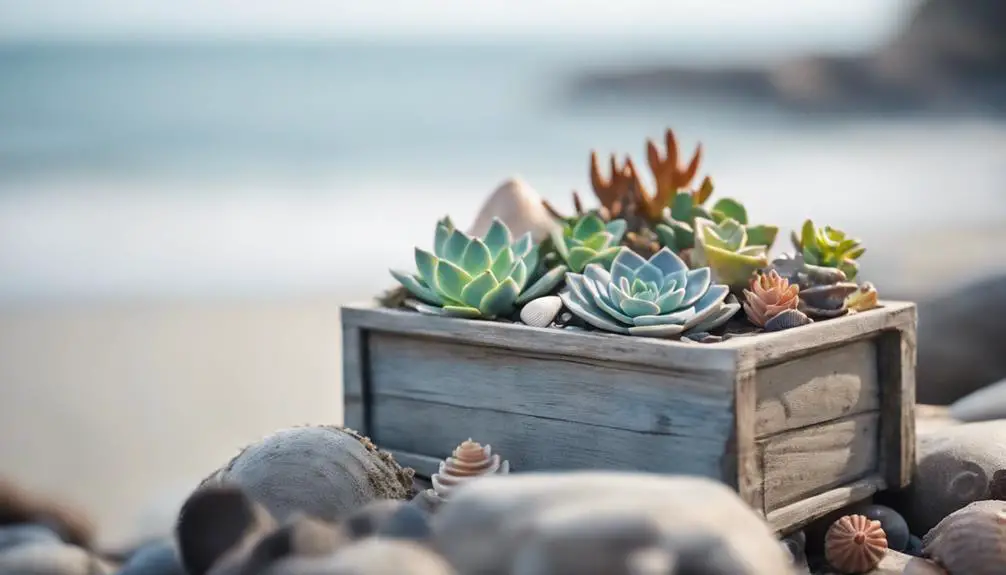
Coastal succulent gardens evoke the natural beauty of seaside landscapes, where rugged, salt-tolerant plants thrive in harsh conditions, and you can replicate this aesthetic in your own backyard by selecting succulents that mimic the shapes and textures of ocean-worn rocks, driftwood, and sea shells.
To create a coastal-inspired succulent garden, choose plants with silvery-gray or blue-green foliage, such as echeveria, crassula, and Sedum. These colors will evoke the ocean's hues and complement oceanic accents like shells, pebbles, and driftwood.
Consider incorporating succulents with wavy or ruffled leaves, like aloe or agave, to mimic the movement of sea waves.
Use a well-draining soil mix and a container with good drainage to prevent waterlogged soil, just like the coastal environment.
Finally, add some decorative elements like sea glass, starfish, or coral to bring the seaside landscapes to life.
With these tips, you'll create a stunning coastal succulent garden that transports you to the beach, no matter where you live.
Succulent Fire Pit Surrounds

Moving from the calming ambiance of coastal succulent gardens, incorporate succulents into your outdoor entertainment area by designing a fire pit surround that's as functional as it's visually appealing.
When it comes to succulent fire pit surrounds, prioritize Succulent Safety by choosing species that are heat-tolerant and resistant to flames. Select succulents like aloe, agave, or echeveria, which can thrive in high-temperature conditions.
When designing your fire pit landscaping, consider the layout and spacing of your succulents. Plant them far enough from the fire pit to prevent damage, but close enough to create a cohesive look.
Use a mix of succulent sizes, textures, and colors to add visual interest. Incorporate decorative rocks, gravel, or mulch to separate the succulents from the fire pit area, creating a clear boundary.
Don't forget to incorporate proper drainage and irrigation systems to guarantee your succulents receive the right amount of water. By following these guidelines, you'll create a stunning and safe succulent fire pit surround that's perfect for outdoor gatherings.
Succulent Wreath Designs
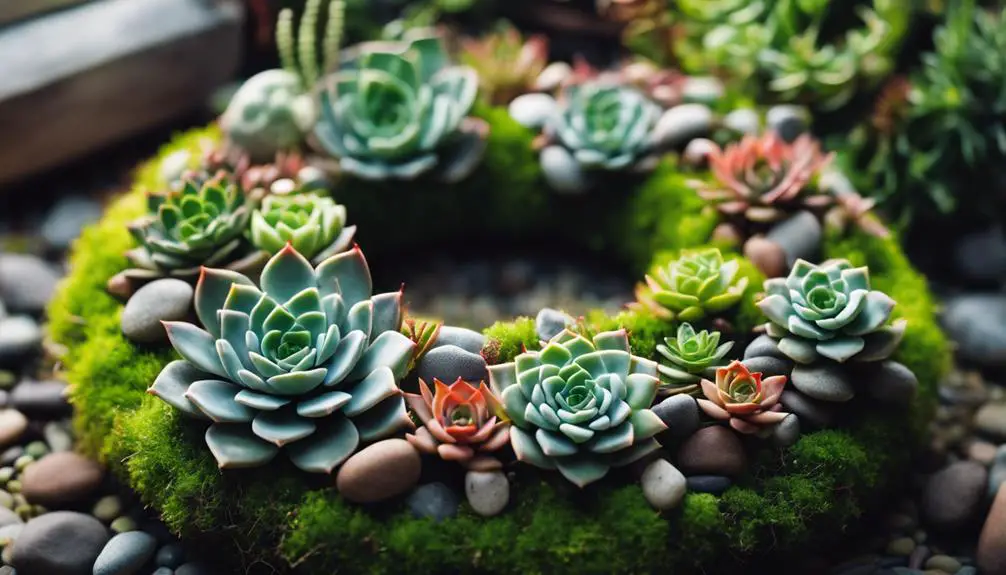
You can create a stunning succulent wreath design by carefully selecting a variety of succulent species and arranging them in a visually appealing pattern.
Consider combining succulents with unique shapes, such as rounded echeverias, elongated sedums, and trailing string of pearls, to add depth and texture to your design. When choosing succulent species, think about their growth habits and how they'll interact with each other in the wreath.
For a modern look, opt for a minimalist wreath style with sparse, strategically placed succulents. For a more rustic look, try a fuller wreath with a mix of succulent shapes and sizes.
To add an extra layer of interest, incorporate decorative elements like moss, pinecones, or small ornaments into your design.
You can also experiment with different wreath styles, such as a circular or oval shape, or a more free-form design. Whatever style you choose, be sure to leave enough space between the succulents for air circulation and growth.
With a little creativity and planning, you can create a one-of-a-kind succulent wreath that showcases your personal style and adds a touch of innovation to your outdoor space.
Frequently Asked Questions
How Often Should I Water My Succulent Garden in Winter?
During winter, you'll want to drastically reduce watering as plants enter dormancy. Check moisture levels regularly, and only water when the soil is dry to the touch, as overwatering can be fatal in cold temperatures.
Can I Grow Succulents in Full Shade or Low Light?
You'll find that most succulents require bright, indirect light, but some species have shade tolerance. Check the light requirements of your specific succulent type, as some can thrive in low light, while others need more intense illumination.
What Is the Best Soil Mix for Succulent Gardens?
When crafting your ideal soil mix, you'll want to aim for a well-draining blend with a slightly acidic to neutral soil pH (6.0-7.0) and incorporate organic amendments like perlite, vermiculite, or coconut coir to promote healthy root growth.
How Do I Prevent Pests From Infesting My Succulent Garden?
To prevent pests from infesting your garden, you'll want to implement integrated pest control methods, using organic pesticides like neem oil and diatomaceous earth to deter unwanted visitors, ensuring a healthy and thriving environment.
Can I Propagate Succulents From Leaf or Stem Cuttings?
You can propagate succulents via leaf or stem cuttings, depending on the Succulent Varieties; some, like Aloe, respond well to leaf cuttings, while others, like Echeveria, thrive with stem cuttings, each requiring specific Propagation Methods.
Conclusion
You've explored a range of succulent garden ideas, from modern containers to whimsical fairy gardens, and from rustic wooden planters to coastal-inspired landscapes.
Each design option offers a unique aesthetic and level of maintenance.
By considering factors like climate, space, and personal style, you can create a succulent garden that suits your needs and enhances your outdoor or indoor space.
With these ideas, you're ready to get creative and bring your vision to life.


